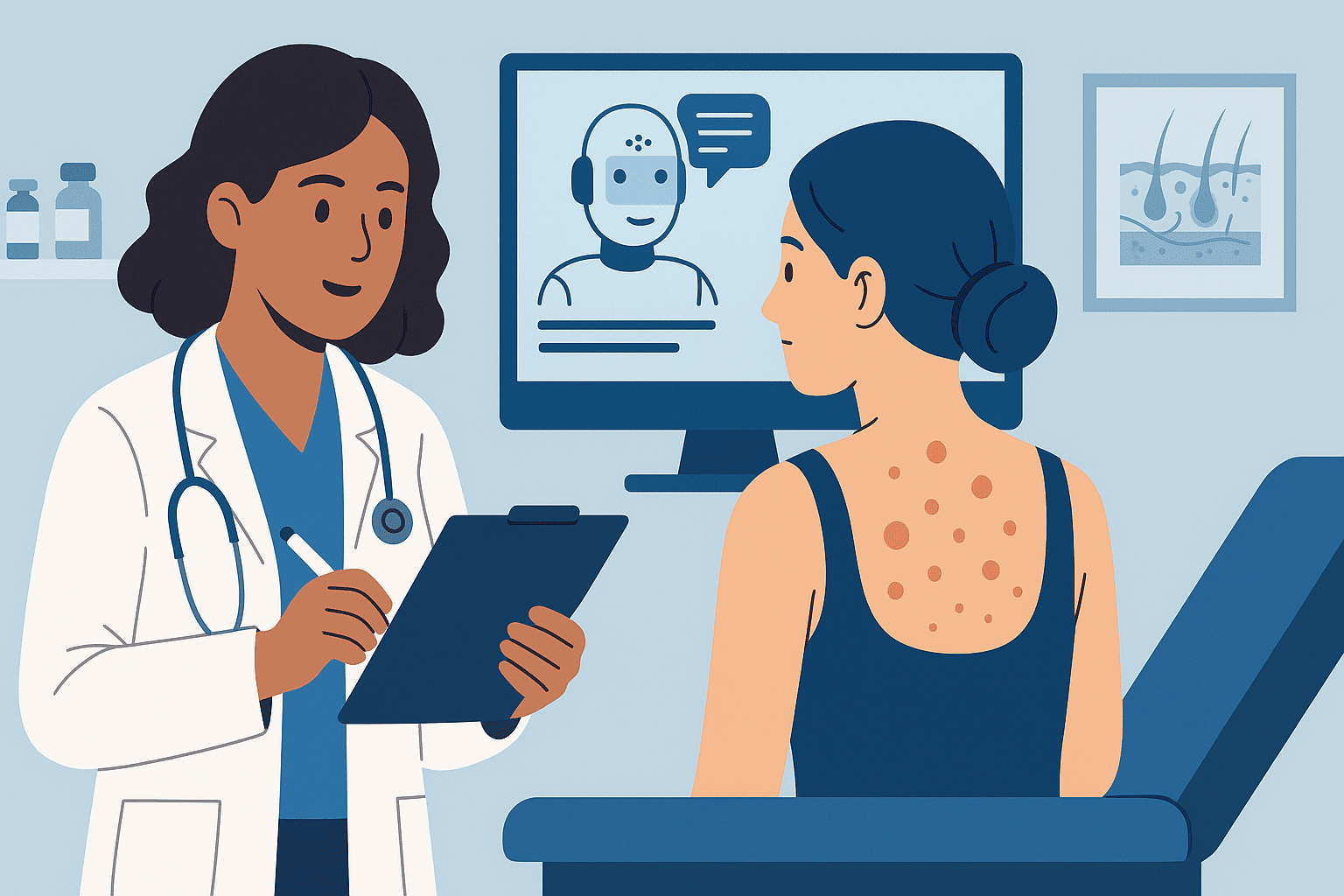Updated on: July 14, 2025
In dermatology, details matter. A 3mm papule on the left cheek isn’t the same as a 3mm papule on the back. Diagnoses are visual, descriptions are nuanced, and documentation has to match what the clinician sees—not just hears.
But with 20–30 patients a day, biopsies, cosmetic procedures, and follow-ups all packed into a tight schedule, even the best dermatologists find themselves buried in notes.
That’s where AI medical scribes for dermatology—like DocScrib—come in. By capturing clinical conversations and generating accurate, anatomic, and procedural notes in real-time, AI scribes are transforming how dermatologists chart—and how fast they finish their day.
Why Dermatology Documentation Is Uniquely Challenging
Dermatologists face a high volume of fast-paced visits—many of which require:
-
Precise anatomic localization (e.g., 1 cm lateral to the right nasal ala)
-
Lesion type and morphology (e.g., pearly papule, erythematous plaque, crusted nodule)
-
Procedural notes (e.g., punch biopsy, cryotherapy, excision with margins)
-
Cosmetic procedure tracking (e.g., Botox units, laser settings, peel concentrations)
-
Differential diagnoses for ambiguous rashes or lesions
-
Before-and-after follow-up tracking for treatment efficacy
And all of this needs to be compliant, billable, and searchable—within seconds.
What Is an AI Medical Scribe for Dermatology?
An AI dermatology scribe listens to clinician-patient interactions and automatically creates structured SOAP notes, procedure documentation, and follow-up entries.
Unlike generic scribes or speech-to-text tools, DocScrib is trained in dermatology language, lesion types, anatomic sites, and dermatologic procedures—making every note accurate and audit-ready.
Whether you’re removing a nevus or counseling on acne treatment, the scribe documents what you say, formats it correctly, and syncs it with your EMR.
How DocScrib Works in a Dermatology Practice
-
During the exam or procedure
DocScrib passively listens to the conversation using secure audio input. -
Real-time comprehension
The AI recognizes descriptive language (e.g., “5 mm pearly papule on the scalp”), procedural steps, and treatment plans. -
Note generation
A SOAP or procedure-specific note is created instantly—with options for template customization. -
Review and submit
The dermatologist reviews the note and pushes it directly into the EMR.
Benefits of AI Scribes for Dermatologists
🎯 Anatomically Precise Documentation
DocScrib maps findings to correct body locations with descriptors like size, shape, color, and texture.
✂️ Accurate Procedure Notes in Seconds
Biopsies, cryo, ED&C, and excisions are auto-documented with appropriate technique, instruments, and CPT fields.
🖼️ Supports Visual Treatment Tracking
AI can include prompts for image capture and link photo documentation to note sections.
🕒 Saves 1–2 Hours a Day
Complete notes during or right after the visit—no end-of-day backlog.
🧴 Cosmetic Dermatology Support
Document Botox units, filler amounts, laser parameters, and patient preferences.
🔐 HIPAA-Compliant & Secure
All documentation is encrypted and stored securely, with full audit logs and BAA availability.
DocScrib for Dermatology: Smart Features Built In
-
Anatomic Site Detection
Auto-recognition of lesion location, side (left/right), and regional terms (e.g., perioral, infraorbital). -
Lesion Descriptor Library
Captures terms like verrucous, umbilicated, hyperkeratotic, macular, vesicular, etc. -
Procedure Templates
Standardized notes for shave, punch, excision, cryo, Mohs, and cosmetic procedures. -
Treatment Timeline Tracking
Auto-carry-forward of prior findings, prescriptions, or lesion counts over time. -
Cosmetic Visit Notes
Include injection sites, filler brands, dilution ratios, and patient aesthetic preferences.
Use Cases for DocScrib in Dermatology Clinics
-
Skin Cancer Screening: Full-body exams with lesion tracking
-
Acne Management: Document lesion types, topical/oral meds, and response
-
Biopsies & Excisions: Pre-op, intra-op, and post-op documentation
-
Cryotherapy: Site, number of lesions, and freeze/thaw cycles
-
Cosmetic Visits: Botox, fillers, PRP, peels, microneedling, lasers
-
Follow-Up Visits: Rash improvement, psoriasis tracking, wound healing
Real-World Example: Dermatology Practice in Los Angeles
📍 5 dermatologists implemented DocScrib across 2 locations
Outcomes after 45 days:
-
90% reduction in after-hours documentation
-
2x faster procedural note turnaround
-
Better lesion mapping and standardization across providers
-
Improved billing accuracy for excisions and cosmetic services
💬 “I don’t have to remember the exact lesion size or site anymore—DocScrib captures it live. It’s like having a derm-trained assistant always listening.”
DocScrib vs. Manual Dermatology Note-Taking
| Feature | Manual Entry | DocScrib AI Scribe |
|---|---|---|
| Anatomic Site Documentation | Prone to inconsistency | ✅ Auto-tagged with side/region |
| Procedure Note Generation | Time-consuming | ✅ Instant with CPT prompts |
| Image-Based Visit Linking | Requires manual steps | ✅ Prompted with placeholders |
| Lesion Description Accuracy | Varies per provider | ✅ Consistent, structured |
| Cosmetic Treatment Notes | Entered separately | ✅ Built into visit note |
| Time Required | 5–7 mins per note | ✅ 1–2 mins per note |
FAQs: AI Scribes in Dermatology Practice
Q1. Can DocScrib capture multiple lesions or procedures in one visit?
Yes. It supports bulk documentation for multiple lesions, including type, size, site, and action taken (e.g., monitored vs biopsied).
Q2. Does it support Mohs or cosmetic dermatology workflows?
Absolutely. You can create templates for Mohs stages, reconstruction, and cosmetic consults with tailored fields.
Q3. Can I use it during full body skin exams?
Yes—DocScrib records findings anatomically and allows mapping or tagging for later follow-up.
Q4. What about image documentation?
While DocScrib doesn’t capture images, it supports image references and links them to the appropriate section in your EMR.
Getting Started with DocScrib for Dermatology
-
Schedule a demo
-
Select “Dermatology” as your specialty
-
Customize templates by visit type and procedure
-
Start documenting faster with fewer clicks and more consistency
Conclusion: Smarter Notes for Sharper Care
Dermatology is visual. Your notes should reflect that—without stealing your time or attention.
DocScrib’s AI scribes for dermatology are built to capture the clinical detail, anatomical precision, and procedural depth your practice demands. Whether you’re removing a lesion or refreshing a face, DocScrib helps you focus on care while it handles the chart.
🎯 Try DocScrib for Dermatology → Book a Demo
